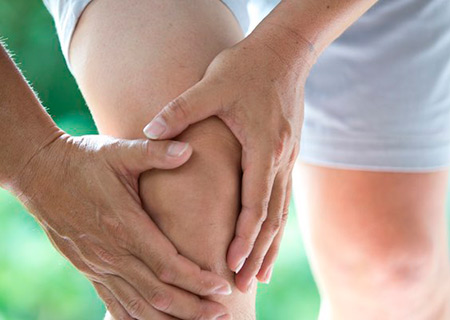
Today is World Arthritis Day so let’s take a look at how Nutritional Therapy can help relieve some of the pain of osteoarthritis.
Osteoarthritis and quality of life
The joint pain and stiffness of osteoarthritis (OA) can severely impact quality of life and sufferers report that this is poorly understood by many doctors. However, by combining nutritional and lifestyle approaches based on individual needs, effective relief may be possible. By following the functional medicine (FM) approach, nutritional therapists (NTs) are ideally positioned to provide effective solutions.
Towards patient understanding
Research released during the European League Against Rheumatism (EULAR) Congress 2016, indicates that rheumatologists underestimate the impact OA has on lives1 and a joint collaboration between Arthritis UK and The Telegraph newspaper, found that one third of respondents feel that healthcare providers do not take their joint pain seriously.2 The condition affects over 8 million and 76 per cent of respondents said that pain prevents them from living life to the full. Currently non-steroidal anti-inflammatory drugs (NSAIDs) or analgesics are prescribed to reduce pain but research shows that there are several nutritional and lifestyle solutions with proven efficacy. Professor Burmester, president of EULAR, suggests that what is needed is a multi-disciplinary approach to treatment.3
Understanding osteoarthritis and current treatment protocols
It is estimated that OA affects around 8 million people in the UK with 33 per cent of people over the age of 45 having sought treatment for the condition rising to 49 per cent of women and 42 per cent of men aged 75 years and over.4
It can also affect younger people, usually as the result of a joint injury, a joint malformation, or a genetic defect in joint cartilage.5 OA is the most common arthritic condition and a leading cause of physical disability and impaired quality of life.5 Joints most commonly affected are the ends of the fingers, thumbs, hips, knees, neck and lower back and all the structures of the joint are affected including cartilage, bone, ligaments, nerves, muscles, synovial fluid and membranes.6
Early symptoms to look out for5:
- Stiffness in a joint after getting out of bed or sitting for a long time
- Swelling in one or more joints
- Crunching feeling or the sound of bone rubbing on bone
OA is usually diagnosed on the basis of clinical examination and radiographic evidence.7 As yet, no specific laboratory tests have been developed to diagnose the condition.7 C-Reactive protein and sedimentation rate tests are sometimes used, to detect inflammation;8 as well as tests to rule out rheumatoid arthritis and gout.9
There are no specific drug therapies.10 Conventional treatments focus on reducing joint inflammation and pain, maintaining joint mobility and minimising disability.7 NSAIDs and paracetamol are used as front-line treatment for mild to moderate pain10 but these may have undesirable side effects such as gastrointestinal issues, ulcers and cardiovascular problems.11 They may also accelerate cartilage degeneration;12 and a recent meta-analysis found paracetamol to be little better than a placebo in relieving pain in OA.13
Non-pharmacologic treatments include heat and cold compresses, exercise, physical therapy to improve movement, occupational therapy and lessening load on certain joints via weight reduction (eg knee, hip).5 Functional decline may be slowed in many patients, including the elderly, by following a long-term walking and resistance-training programme.7 Hip replacement is usually a last resort.
Summary of evidence-based guidelines for osteoarthritis (OA)*
Worldwide it is recognised that it is necessary to assess the needs of each individual and to adapt the treatment plan accordingly.10 However, it seems that doctors have difficulty implementing effective treatment programmes perhaps due to time or resources.17
Why do I have osteoarthritis?
There are several risk factors for OA including age, family history, major trauma to a joint or to soft tissues surrounding a joint (eg a sporting injury), repetitive joint stress related to occupation, reduced levels of sex hormones, infection and obesity.7
In the past it was thought that OA was caused only by wear and tear, however it has now been established that the inflammatory response is involved creating cartilage degeneration.6,18
Oxidation and resulting reactive oxygen species (ROS) damage accumulates with age causing conditions such as coronary artery disease and some cancers and OA may similarly be regarded as an age-related degenerative disease.19
Women tend to develop OA later in life than men and a higher proportion of women than men have the disorder after the age of 755 this may be the result of lowered oestrogen production which has a pro-inflammatory effect.18
OA that starts at an early age appears to have a genetic connection, a gene mutation which weakens collagen has been discovered.5
Some current research is focusing on the role of infection in OA. The innate immune system may be critical in starting inflammation of the body’s tissues.5
Nutrient deficiencies have been linked to OA. For example, magnesium deficiency appears to be a major risk factor for OA development and progression23 (further deficiencies are discussed below).
It is clear that several physiological processes may contribute to the onset of OA and that it important to consider the potential risk factors of the individual rather than using a one-size-fits-all approach.
A nutritional therapy approach to osteoarthritis
Functional Medicine looks for underlying causes of disease and considers the signs and symptoms of biological imbalance displayed by OA sufferers. The model is an ideal approach to treating OA as it considers the individual with the disease and their unique make-up. Nutritional therapists trained in FM methods can suggest effective programmes for patients aimed at restoring balance in the body without having to resort to anti-inflammatory drugs or analgesics.
General nutritional advice
There is increasing evidence supporting the use of various therapeutic and functional foods and isolated compounds thereof in the treatment of OA (see box) though much of the research in inconclusive with further studies needed. What is clear is that many of the foods that may be effective contain phytochemicals, are high in antioxidants and have anti-inflammatory properties.
Since it has been shown that OA may be caused by or result in inflammation and/or oxidative stress it follows that a diet that can reduce these effects may be helpful in reducing the symptoms associated with OA. A predominantly whole-food, plant-based diet such as the Mediterranean Diet, high in antioxidants and phytonutrients, has been proven to be beneficial for OA.17 This should include consumption of oily fish, three times per week to increase Omega-3 levels, use of extra-virgin olive oil, at least seven portions of fruit and vegetables per day to boost antioxidants as well as regular consumption of whole grains and pulses. The British Association of Applied and Nutritional Therapy’s Healthy Plate is an ideal guideline to follow (see Resources below). One recent study found a whole foods plant based vegan diet to be effective.24
Sugar, highly refined carbohydrates and trans fats should be avoided as they create inflammation.
Research on 1400 volunteers during a 20-year period, by Childers & Margoles25 suggests that some people appear to be sensitive to nightshade (Salanaceae) family plants, and avoidance has relieved symptoms. Foods to avoid include potato, tomato and peppers.
Testing for individual deficiencies
Given the role of inflammation in OA and taking into account nutritional deficiencies (see below) linked to the condition, the NT may suggest the following functional tests:
- Fatty Acid Analysis – to determine the ratio of anti-inflammatory omega-3 fats to inflammatory omega-6 fats.
- Comprehensive Digestive Stool Analysis – to determine if gut related dysfunctions could be contributing to inflammation.
- Intestinal Permeability Assessment –increased intestinal permeability (“leaky gut”) which allows bacteria, toxins and allergens to cross the gut wall may trigger the inflammatory response.
- Amino Acid Testing – amino acids such as cysteine, taurine and methionine are important anti-inflammatory agents.26
Options tailored to the individual patient
Testing – Consider if any of the tests above are appropriate and act to repair imbalances that may be detected as a result of these. This may involve improving gut health or recommending way of improving fatty acid balance or increasing amino acid consumption. With or without testing, since inflammation can be caused by gut hyper permeability, healing the gut may be a priority.
Weight–loss – Recommend a weight-loss programme if necessary, a loss of only 5kg can reduce the risk of developing knee OA by 50%19 and reduce inflammatory mediators.
Nutrient deficiencies– Specific attention should be paid to possible nutrient deficiencies. Antioxidant vitamins A, C and E have been found to reduce the symptoms of OA;19 and vitamin C has been found to be effective, in vitro, in reducing the oxidative stress that is an important cause of cartilage degradation and dysfunction leading to development of OA.27 Individuals deficient in vitamin D have an increased risk of knee OA progression.28 OA sufferers have been found to have lower levels of vitamin E (especially alpha-tocopherol) levels than non-sufferers.29 Low vitamin K status is associated with OA.30 Magnesium deficiency appears to be a major risk factor for OA development and progression and animal research suggests that nutritional supplementation and local infiltrations may be effective therapies.23
Therapeutic foods – Consider specific foods to include in the diet (see table below).
Specific therapeutic and functional foods which may be useful in relieving OA symptoms
- Burdock root tea improves inflammation and oxidative stress in patients with knee osteoarthritis.31
- Curcumin may be an effective treatment in improving mobility, pain, cartilage regeneration and quality of life.32
- Pomegranate seed oil has been found to prevent the onset of OA. Its high antioxidant content has cartilage protective effects.33
- Sesame seeds have been shown to reduce pain and improve clinical signs and symptoms.34
- Green tea may be effective because of its antioxidant properties.35
Exercise – Exercise such as walking or swimming should be recommended for improved joint movement as well as for its anti-inflammatory effects.17
Relax – Meditation, deep breathing and guided imagery have proven pain relieving effects36 and managing stress may reduce inflammation.17
Alcohol consumption – should ideally be restricted to red wine and no more than 14 units a week.37
Stop smoking – smokers should be advised to stop.17
OA needs a multi-disciplinary approach and nutritional therapy can be one part of the toolkit in providing solutions to pain. FM offers hope that the underlying cause of the condition can be treated. In addition, NTs can offer advice on various therapies and lifestyle factors that can enhance quality of life for OA sufferers.
Resources
BANT Wellbeing Guidelines available at http://bant.org.uk/about-nutritional-therapy/bant-wellbeing-guidelines/.
Reference List
1. EULAR (2016) Osteoarthritis just as severe as rheumatoid arthritis. Accessed: http://www.eular.org/congresspressreleases/Osteoarthritis_just_as_severe_as__Rheumatoid_Arthritis_–_OP0094.pdf, 20 June 2016.
2. Telegraph (2016) Arthritis Research UK vital statistics and facts. Accessed: http://www.telegraph.co.uk/wellbeing/arthritis-research-uk/vital-statistics-and-facts/, 20 June 2016.
3. Medscape (2016) Impact of Osteoarthritis Underrated by Rheumatologists. Accessed: http://www.medscape.com/viewarticle/864525, 20 June 2016.
4. Arthritis Research UK (2013) Arthritis data by condition – osteoarthritis. Accessed: http://www.arthritisresearchuk.org/arthritis-information/data-and-statistics/data-by-condition/osteoarthritis.aspx, 20 June 2016.
5. NIAMS (2015) Osteoarthritis. Accessed: http://www.niams.nih.gov/Health_Info/Osteoarthritis/default.asp#2, 20 June 2016.
6. Poole AR (1999) An introduction to the pathophysiology of osteoarthritis. Frontiers in bioscience : a journal and virtual library, 4:D662–70.
7. Lozada et al (2015) Osteoarthritis. Accessed: http://emedicine.medscape.com/article/330487-overview#a1, 20 June 2016.
8. Smith JW et al (2012) Significance of C-reactive protein in osteoarthritis and total knee arthroplasty outcomes. Therapeutic advances in musculoskeletal disease, 4:315–25.
9. Lab Tests Online (2013) Osteoarthritis. Accessed: https://labtestsonline.org/understanding/conditions/osteo/start/1, 25 June 2016.
10. Barr A & Conaghan PG (2012) Osteoarthritis: a holistic approach. Clinical Medicine, 12:153–155.
11. Wang K et al (2015) Investigational drugs for the treatment of osteoarthritis. Expert Opinion on Investigational Drugs, 24:1539–1556.
12. Zhang W et al (2010) OARSI recommendations for the management of hip and knee osteoarthritis: Part III: changes in evidence following systematic cumulative update of research published through January 2009. Osteoarthritis and Cartilage, 18:476–499.
13. da Costa P et al (2015) Curcumin attenuates memory deficits and the impairment of cholinergic and purinergic signaling in rats chronically exposed to cadmium. Environmental toxicology.
14. Arthritis Foundation (nd) Chondroitin Sulfate and Glucosamine Supplement is Osteoarthritis. Accessed: http://www.arthritis.org/living-with-arthritis/treatments/natural/supplements-herbs/glucosamine-chondroitin-osteoarthritis.php, 26 June 2016.
15. University of Maryland Medical Centre (2015) S-adenosylmethionine. Accessed: http://umm.edu/health/medical/altmed/supplement/sadenosylmethionine, 21 June 2016.
16. Christiansen BA et al (2015) Management of Osteoarthritis with Avocado/Soybean Unsaponifiables. Cartilage, 6:30–44.
17. Dean E & Gormsen Hansen R (2012) Prescribing optimal nutrition and physical activity as interventions for best practice management of chronic low-grade inflammation associated with osteoarthritis: evidence synthesis. Arthritis, 2012:
18. Berenbaum F (2013) Osteoarthritis as an inflammatory disease (osteoarthritis is not osteoarthrosis!). Osteoarthritis and Cartilage, 21:16–21.
19. McAlindon T & Felson DT (1997) Nutrition: risk factors for osteoarthritis. Annals of the Rheumatic Diseases, 56:397–400.
20. Kluzek S, Newton JL & Arden NK (2015) Is osteoarthritis a metabolic disorder? British medical bulletin, 115:111–21.
21. Abramson SB et al (2009) Developments in the scientific understanding of osteoarthritis. Arthritis Research & Therapy, 11:227
22. Sellam J & Berenbaum F (2013) Is osteoarthritis a metabolic disease? Joint Bone Spine, 80:568–573.
23.Li Y, Yue J & Yang C (2016) Unraveling the role of Mg++ in osteoarthritis. Life Sciences, 147:24–29.
24. Clinton CM et al (2015) Whole-foods, plant-based diet alleviates the symptoms of osteoarthritis. Arthritis, 2015:708152.
25. Childers NF & Margoles MS (1993) An Apparent Relation of Nightshades (Solanaceae) to Arthritis. Accessed: http://www.noarthritis.com/research.htm, 26 June 2016.
26. Amino Acid Studies (2016) Osteoarthritis. Accessed: http://aminoacidstudies.org/osteoarthritis/, 20 June 2016.
27. Chang Z et al (2015) Ascorbic acid provides protection for human chondrocytes against oxidative stress. Molecular medicine reports, 12:7086–92.
28. Zhang FF et al (2014) Vitamin D Deficiency Is Associated with Progression of Knee Osteoarthritis. Journal of Nutrition, 144:2002–2008.
29. Jordan JM et al (2004) A case-control study of serum tocopherol levels and the alpha- to gamma-tocopherol ratio in radiographic knee osteoarthritis: the Johnston County Osteoarthritis Project. American journal of epidemiology, 159:968–77.
30. Neogi T et al (2006) Low vitamin K status is associated with osteoarthritis in the hand and knee. Arthritis and rheumatism, 54:1255–61.
31. Maghsoumi-Norouzabad L et al (2016) Effects of Arctium lappa L. (Burdock) root tea on inflammatory status and oxidative stress in patients with knee osteoarthritis. International journal of rheumatic diseases, 19:255–61.
32. Appelboom T, Maes N & Albert A (2014) A new curcuma extract (flexofytol®) in osteoarthritis: results from a belgian real-life experience. The open rheumatology journal, 8:77–81.
33. Rasheed Z (2016) Intake of Pomegranate Prevents the Onset of Osteoarthritis: Molecular Evidences. International journal of health sciences, 10:V–VIII.
34. Eftekhar Sadat B et al (2013) Effects of sesame seed supplementation on clinical signs and symptoms in patients with knee osteoarthritis. International journal of rheumatic diseases, 16:578–82.
35. Akhtar N & Haqqi TM (2012) Current nutraceuticals in the management of osteoarthritis: a review. Therapeutic advances in musculoskeletal disease, 4:181–207
36. Web MD (2016) Hypnosis, meditation and relaxation for pain treatment. Accessed: http://www.webmd.com/pain-management/hypnosis-meditation-and-relaxation-for-pain-treatment, 27 June 2016.
37. Drinkaware (2016) Alcohol limits unit guidelines. Accessed: https://www.drinkaware.co.uk/alcohol-facts/alcoholic-drinks-units/alcohol-limits-unit-guidelines/, 26 June 2016.





